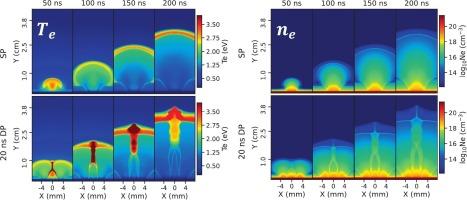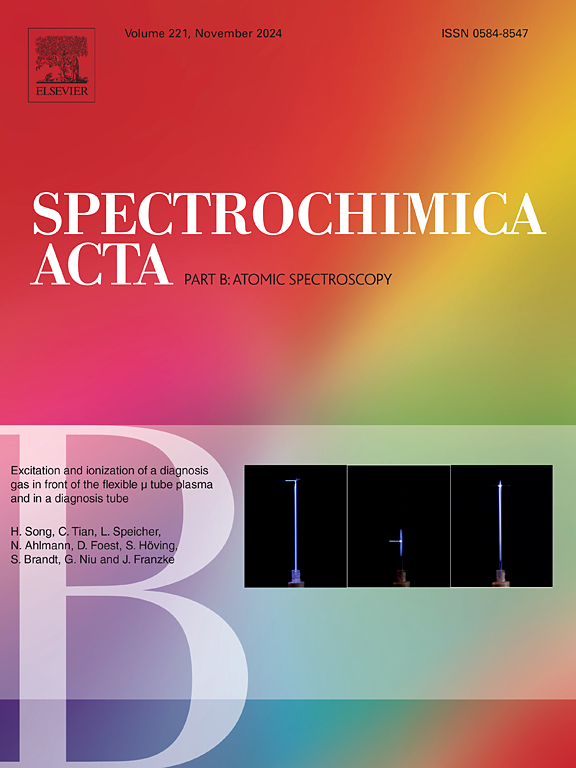利用环点双脉冲结构数值模拟激光诱导硼等离子体的时空演化
IF 3.8
2区 化学
Q1 SPECTROSCOPY
引用次数: 0
摘要
环形点双脉冲激光诱导击穿光谱(DP-LIBS)是一种显著提高等离子体参数以放大光谱发射强度的有效方法,可用于核聚变装置共沉积层的分析。采用二维数值模型,描述了10−4 mbar压力下激光-材料相互作用、蒸汽羽流膨胀、等离子体形成和激光-等离子体相互作用,利用环点双脉冲配置研究了激光诱导硼等离子体的时空演变,这对LIBS技术的分析能力至关重要。在相同的激光能量和激光通量下,环形点双脉冲配置比常规单脉冲配置显著提高了等离子体温度。在18 J/cm2的激光辐照下,我们研究了一系列脉冲间延迟时间,发现20 ns的延迟时间表现出最佳性能,在第二个脉冲后的较长时间内保持电子温度超过2.5 eV。定量地说,这种最佳配置的电子温度大约是单脉冲配置的1.7-2.2倍,并且电子密度保持在1016-1017 cm−3范围内。温度的增强是由于环形预脉冲等离子体和后续点脉冲等离子体的碰撞,形成了一个明确的停滞层。本文章由计算机程序翻译,如有差异,请以英文原文为准。

Numerical simulation of spatial and temporal evolution of laser-induced boron plasma using annular-point double pulse configuration
The annular–point double pulse laser-induced breakdown spectroscopy (DP-LIBS) is an effective way of significantly enhancing plasma parameters to amplify the spectral emission intensity for analysis of co-deposition layers in fusion devices. A two-dimensional numerical model, describing laser–material interaction, vapor plume expansion, plasma formation and laser–plasma interaction at a pressure of 10−4 mbar, was applied to investigate spatial and temporal evolutions of laser-induced boron plasma using annular–point double pulse configuration, which is crucial for analytical capabilities of LIBS techniques. The annular-point double pulse configuration demonstrated significant enhancement in plasma temperature compared to conventional single pulse configuration, under the same laser energy and laser fluence. At a laser fluence of 18 J/cm2, we examined a series of inter-pulse delay times and found that the 20 ns delay time exhibited optimal performance, maintaining electron temperatures exceeding 2.5 eV for extended periods after the second pulse. Quantitatively, this optimal configuration achieved electron temperatures approximately 1.7–2.2 times as high as those in single-pulse configuration and maintained electron densities in the 1016–1017 cm−3 range. The temperature enhancement resulted from the collision between the annular pre-pulse plasma and the subsequent point pulse plasma, forming a well-defined stagnation layer.
求助全文
通过发布文献求助,成功后即可免费获取论文全文。
去求助
来源期刊
CiteScore
6.10
自引率
12.10%
发文量
173
审稿时长
81 days
期刊介绍:
Spectrochimica Acta Part B: Atomic Spectroscopy, is intended for the rapid publication of both original work and reviews in the following fields:
Atomic Emission (AES), Atomic Absorption (AAS) and Atomic Fluorescence (AFS) spectroscopy;
Mass Spectrometry (MS) for inorganic analysis covering Spark Source (SS-MS), Inductively Coupled Plasma (ICP-MS), Glow Discharge (GD-MS), and Secondary Ion Mass Spectrometry (SIMS).
Laser induced atomic spectroscopy for inorganic analysis, including non-linear optical laser spectroscopy, covering Laser Enhanced Ionization (LEI), Laser Induced Fluorescence (LIF), Resonance Ionization Spectroscopy (RIS) and Resonance Ionization Mass Spectrometry (RIMS); Laser Induced Breakdown Spectroscopy (LIBS); Cavity Ringdown Spectroscopy (CRDS), Laser Ablation Inductively Coupled Plasma Atomic Emission Spectroscopy (LA-ICP-AES) and Laser Ablation Inductively Coupled Plasma Mass Spectrometry (LA-ICP-MS).
X-ray spectrometry, X-ray Optics and Microanalysis, including X-ray fluorescence spectrometry (XRF) and related techniques, in particular Total-reflection X-ray Fluorescence Spectrometry (TXRF), and Synchrotron Radiation-excited Total reflection XRF (SR-TXRF).
Manuscripts dealing with (i) fundamentals, (ii) methodology development, (iii)instrumentation, and (iv) applications, can be submitted for publication.

 求助内容:
求助内容: 应助结果提醒方式:
应助结果提醒方式:


